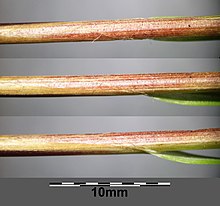Felt sedge
| Felt sedge | ||||||||||||
|---|---|---|---|---|---|---|---|---|---|---|---|---|

Felt sedge ( Carex tomentosa ) |
||||||||||||
| Systematics | ||||||||||||
|
||||||||||||
| Scientific name | ||||||||||||
| Carex tomentosa | ||||||||||||
| L. |
The felt-sedge ( Carex tomentosa ), also known as the felt- fruited sedge , is a member of the sour grass family (Cyperaceae) that grows scattered or rarely in Central Europe.
description

The felt sedge is a perennial, herbaceous plant that reaches heights of about 20 to 40 cm and has long runners . The stiff, upright, triangular stem is only coarsely hairy on top and has a black-red leaf sheath at the base. The stem leaves are gray-green, no more than 2 mm wide and have a triangular tip.
The lowest bract is formed like a leaf and towers over the spikelet. In the end it often sticks out horizontally. Usually the plant has one or two female spikelets about 0.5 to 1.5 cm long and one terminal male spikelet. These are cylindrical in shape, with short stems and a little distant. The fruity spikelets are whitish and brown piebald. The husks are pointed, red to light brown in color and have a green central nerve. The fruit sacs are 1.5 to 2 mm long, gray-brown in color, spherical-inverted-egg-shaped, almost beakless and covered with whitish tomentose hair.
It blooms mainly in May and June.
The number of chromosomes is 2n = 48.
Occurrence
Carex tomentosa occurs from southern Scandinavia and England to northern Italy, the Balkans and east to western Siberia and Central Asia. It is a temperate continental floral element. In Austria the species is absent-minded and endangered, while it is common in Switzerland. The felt sedge occurs in Germany only scattered in the central and southern areas. It is absent in northern Germany as well as in the low mountain ranges and in the Alps in larger areas.
It prefers to colonize wet meadows, ditch edges and light, somewhat damp deciduous forests. It barely rises above 1500 m in the Alps. In the Allgäu Alps, it barely exceeds the 800 meter altitude limit. The felt sedge needs summer-dry, but winter and spring moist, loamy or clayey, lime or base-rich, nitrogen-poor soil in a location that is not too shaded. It is a character species of the order Molinietalia, but also occurs in the Querco-Ulmetum of the Alno-Ulmion association.
The felt sedge does not tolerate fertilization very well and has therefore disappeared from grassland locations in many places. In humid littered meadows it was still found in large stocks in Central Europe around 1900 .
Species protection
Hazard in Germany: Category 3: endangered
literature
- Henning Haeupler, Thomas Muer: picture atlas of the fern and flowering plants of Germany . Ed .: Federal Agency for Nature Conservation (= The fern and flowering plants of Germany . Volume 2 ). Eugen Ulmer, Stuttgart (Hohenheim) 2000, ISBN 3-8001-3364-4 .
- Wolfgang Adler, Karl Oswald, Raimund Fischer: Excursion flora of Austria . Ed .: Manfred A. Fischer. Eugen Ulmer, Stuttgart / Vienna 1994, ISBN 3-8001-3461-6 .
- Christian Heitz: School and excursion flora for Switzerland. Taking into account the border areas. Identification book for wild growing vascular plants . Founded by August Binz. 18th completely revised and expanded edition. Schwabe & Co., Basel 1986, ISBN 3-7965-0832-4 .
- Erich Oberdorfer : Plant-sociological excursion flora . With the collaboration of Theo Müller. 6th, revised and expanded edition. Eugen Ulmer, Stuttgart (Hohenheim) 1990, ISBN 3-8001-3454-3 .
- Konrad von Weihe (ed.): Illustrated flora. Germany and neighboring areas. Vascular cryptogams and flowering plants . Founded by August Garcke. 23rd edition. Paul Parey, Berlin / Hamburg 1972, ISBN 3-489-68034-0 .
Individual evidence
- ↑ a b Erich Oberdorfer : Plant-sociological excursion flora for Germany and neighboring areas . With the collaboration of Angelika Schwabe and Theo Müller. 8th, heavily revised and expanded edition. Eugen Ulmer, Stuttgart (Hohenheim) 2001, ISBN 3-8001-3131-5 , pp. 184 .
- ↑ Rafaël Govaerts (ed.): Carex tomentosa. In: World Checklist of Selected Plant Families (WCSP) - The Board of Trustees of the Royal Botanic Gardens, Kew . Retrieved October 25, 2016.
- ↑ a b c d e f Dietmar Aichele, Heinz-Werner Schwegler: The flowering plants of Central Europe . 2nd Edition. tape 5 : Swan flowers to duckweed plants . Franckh-Kosmos, Stuttgart 2000, ISBN 3-440-08048-X , p. 276 .
- ↑ Erhard Dörr, Wolfgang Lippert : Flora of the Allgäu and its surroundings. Volume 1, IHW, Eching 2001, ISBN 3-930167-50-6 , p. 261.
Web links
- Felt sedge. In: FloraWeb.de.
- Felt sedge . In: BiolFlor, the database of biological-ecological characteristics of the flora of Germany.
- Profile and distribution map for Bavaria . In: Botanical Information Hub of Bavaria .
- Carex tomentosa L. In: Info Flora , the national data and information center for Swiss flora .
- Distribution in the northern hemisphere from: Eric Hultén, Magnus Fries: Atlas of North European vascular plants. 1986, ISBN 3-87429-263-0 at Den virtuella floran. (swed.)
- Thomas Meyer: Data sheet with identification key and photos at Flora-de: Flora von Deutschland (old name of the website: Flowers in Swabia )
Photos:



